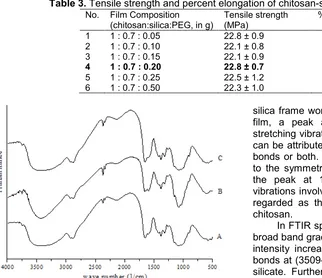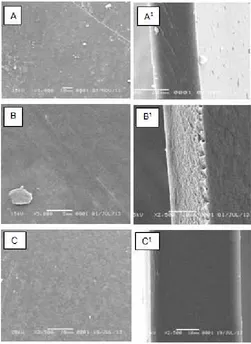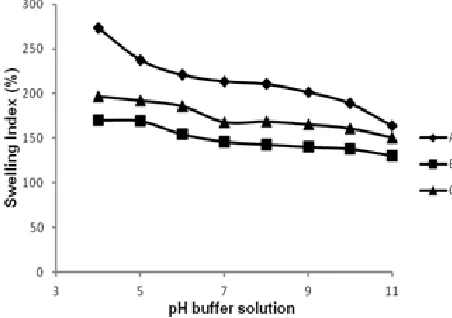PHYSICAL CHARACTERISTICS OF CHITOSAN BASED FILM
MODIFIED WITH SILICA AND POLYETHYLENE GLYCOL
F. Widhi Mahatmanti
1,2,*, Nuryono
2, and Narsito
2 1Department of Chemistry, Faculty of Mathematics and Natural Sciences, Semarang State University, Jl. Raya Sekaran Gunungpati Semarang 50229, Indonesia
2
Department of Chemistry, Faculty of Mathematics and Natural Sciences, Universitas Gadjah Mada, Sekip Utara Yogyakarta 55281, Indonesia
Received November 25, 2013; Accepted April 8, 2014
ABSTRACT
Recently, development of film materials is focused on finding the films with high chemical and physical stabilities. Organic based material such as chitosan produces films with low physical stability, and hence addition of inorganic materials is necessary. In this research, the effect of silica and polyethylene glycol (PEG) addition on the properties of chitosan based films has been investigated. Precursors used to produce films included chitosan with the deacetylation degree of 83% and sodium silicate solution as the silica source. A simple synthesis in a one-pot process was carried out by mixing 1%(w) of chitosan solution in 2%(v/v) acetate acid and sodium silicate solution (27% SiO2) in various composition ratios and casting the solution on a glass dish. The tensile strength and
percentage of elongation decrease with increasing the silica content. The tensile strength tends to decline with addition of PEG, but the elongation percentage of the film increases. Hydrophilicity of the film decreases with the addition of silica and increases with the addition of PEG. The addition of silica and PEG does not change significantly the morphology of the film and functional groups indicating the domination of physical interaction among active sites in the film components.
Keywords:composite; silica; film; chitosan
ABSTRAK
Baru-baru ini, pengembangan material film difokuskan pada film yang mempunyai stabilitas kimia dan fisik yang tinggi. Material organik seperti kitosan menghasilkan film dengan stabilitas mekanik yang rendah, sehingga diperlukan penambahan material anorganik. Dalam penelitian ini, pengaruh penambahan silika dan polietilen glikol (PEG) pada sifat film kitosan dipelajari. Prekursor yang digunakan untuk mensintesis film adalah kitosan dengan derajat deasetilasi 83% dan larutan natrium silikat sebagai sumber silika. Sintesis sederhana dilakukan dalam satu wadah dengan mencampurkan 1% (b) larutan kitosan dalam 2% (v/v) asam asetat dan larutan natrium silikat (27% SiO2) pada berbagai rasio komposisi serta pencetakan larutan pada cetakan kaca. Nilai kuat tarik dan persen
perpanjangan akan menurun dengan penambahan silika. Nilai kuat tarik cenderung menurun dengan penambahan PEG tetapi harga persen perpanjangan meningkat. Hidrofilisitas film menurun dengan penambahan silika dan meningkat dengan penambahan PEG. Penambahan silika dan PEG tidak signifikan mengubah struktur amorf dan gugus fungsional film yang mengindikasikan dominasi interaksi fisik di antara situs aktif yang ada pada komponen film.
Kata Kunci:komposit; silika; film; kitosan
INTRODUCTION
Chitosan is biopolymer derivate of chitin and a polysaccharide found abundantly in crustacean exoskeletons of crab, shrimp, and lobster as a well as in cuttlebone of cuttlefish. The structure of chitosan is a linear chain of linked 2- acetoamido-2 deoxy-β-D-glycopyranose units. Chitosan is also multifunctional polymer containing large numbers of reactive amine
separation techniques, optical material, and so forth [1-2].
However, the poor physical/mechanical properties and high degree swelling of chitosan film in an aqueous system limit its practical application. One way to overcome these limitations effectively and conveniently is by creating chemical cross-linking. On the other hand, formation of organic-inorganic composite film provides another approach to improve the physicochemical properties of chitosan and other biomaterials. Introduction of silica into the chitosan film increases its oxygen permeability, biocompatibility, and biodegradability [1-8].
The interest of inorganic-organic film has to be found in the possible tailoring of the solid-state properties in relation to the nature and relative content of the constitutive organic and inorganic component [2]. Chitosan-silica composite for pH-sensitive film [2] and biodegradable/biocompatible materials prepared from tetraethoxysilane (TEOS) [2], tetraethoxysilane/vinyl triethoxysilane (TEOS/VTES) [1], 3-aminopropyltriethoxy silane [7], α-(glycidyloxypropyl)trimethoxysilane (GPTMS) [1], polydimethylsiloxane [8] have been reported.
Besides above materials, sodium silicate solution from rice hull ash silica has been reported as precursor silica for preparation of silica based films [9]. Silicate films showed moderate strength and flexibility, their barrier properties for non-polar organic solvents could be utilized for separating polar components from non-polar in the vapor phase or adsorption of polar compounds from a non-aqueous medium. The addition of sodium silicate from rice hull ash silica in the production of chitosan-silica film has been reported [10]. Based on the results of this study it can be concluded that the addition of silica affects the pore size of the chitosan-silica film. Particles of silica are ideal porogens for producing porous chitosan-silica film with controlled porosity and good mechanical properties [11].
The silica network is formed from the self condensation reaction of the hydrolyzed Si-OH groups. In spite the formation of hydrogen bonding between the silanol groups and the chitosan film that is expected to promote the compatibility between the organic and the inorganic phases, the lack of covalent bonding in the silica and polymer domains certainly to limit their compatibility [2]. The thermo stability and mechanical performances of the composite films are higher than that of chitosan film and increased with increasing the amount of silica added. However, the mechanical performance deteriorates with the excessive silica [1-3, 5-8]. Addition of food-grade plasticizers (polyethylene glycol, PEG) to film-forming alleviates this problem. When plasticizer is added, the molecular rigidity of a polymer is relieved by reducing the intermolecular forces
along the polymer chain. The plasticizer improves flexibility and reduces brittleness of the film [11].
In this paper synthesis and characterization of chitosan-silica film in a one-pot process using sodium silicate solution as the silica source is reported. Additionally, the effect of the polyethylene glycol addition on the properties of the chitosan-silica composite film was evaluated. The physical properties of chitosan based film modified with silica and polyethylene glycol was observed.
EXPERIMENTAL SECTION
Materials
Chitosan with the deacetylation degree of 83% was supplied from CV Ocean Fresh Bandung. Polyethylene-glycol (MW 400), sodium silicate solution (8% Na2O, 27% SiO2), sodium hydroxide and acetic
acid (2% v/v) all in analytical grade were purchased from Merck.
Instrumentation
The instruments used for characterization included Fourier Transform Infrared (FTIR) spectrometer (Shimadzu Prestige-21) for identifying the presence of functional groups, Scanning Electron Microscope (SEM, JSM-6360 LA) for characterizing the morphology. A Shimadzu X-ray diffractometer (XRD) with Cu-Kα radiation was used for evaluating the crystalline level of the films, Pearson Panke equipment Ltd for measuring the mechanical parameters, and Thermogravimetric Analysis (TGA) (Perkin-Elmer TGA-7) for evaluating thermal stability.
Procedure
Preparation of chitosan-silica film
Table 1.Amounts of chitosan and silica for preparing film with different mass ratio
No. Chitosan 1% (w) in 2% (v/v) acetate acid (g)
Table 2.Tensile strength and percent elongation of chitosan-silica composite film
No. Film composition (chitosan:silica, in g) Tensile strength (MPa) % Elongation
1 1 : 0 24.1 ± 1.1 19.7 ± 0.1
by adding varying the mass of PEG (0.05-0.50 g) on chitosan-silica to evaluate effect of PEG content on the film properties.
Characterizations
The mechanical properties of the film in dry state were performed at 25 °C using a universal material testing instrument with a crosshead speed of 10 mm/min. The results were presented in mean values of three independent measurements. The surface morphology was investigated with Scanning Electron Microscope after gold coating. The fractured cross-sections of the films were achieved by breaking the samples deeply cooled in liquid nitrogen. Fourier Transform- Infrared (FT-IR) spectra were obtained under dry air at a room temperature on KBr pellets in the range of 4000-500 cm-1. An X-Ray diffractometer was used to record the diffractograms of the films at 25 °C. The X-Ray source was Ni-filtered Cu Kα radiation (40 kV and 30 mA). The dry films were mounted on a sample holder and the pattern was recorded in the reflection mode at an angle 2θ over a range of 3.0200° to 70° at a speed of 5°/min. Thermo-gravimetric (TG) data was performed for a 10 mg sample from room temperature to 800 °C at heating rate of 10 °C/min in a dynamic (30 mL/min) synthetic air atmosphere. For determination of swelling index (SI), a procedure reported by Chen et al. [6] was
used. The pH dependent on swelling properties of the film, pre- weighed dry samples was immersed in buffer solutions at pH of 2.0-11.0. After 24 h, the swollen films were removed, excess water was bottled from the surface, and then were weighted. The following equation was used to determine SI.
SI (%) = [(ww-wd) / wd] x 100%,
where wwand wdare the sample weights after swelling
for 24 h and dry state, respectively. In each specimen, three samples were tested.
RESULT AND DISCUSSION
The Effect of Silica and PEG on the Mechanical Property of the Films
Table 3.Tensile strength and percent elongation of chitosan-silica-PEG composite film
Fig 1.FTIR spectra of chitosan film (A), chitosan-silica = 1:0.70 (B), chitosan-silica:PEG = 1:0.70:0.20 (C)
silica content. The high silica content would bring chitosan-silica films to high inorganic characters such as the brittleness and makes low elongation at break. The test results revealed that formation chitosan-silica films did not bring positive effect on improving the mechanical properties of the film.
Effect of the PEG addition on the tensile strength and elongation percentage of the chitosan-silica films is expressed in Table 3, showing that blending with PEG changes the properties of the film. The tensile strength tends to decline with addition of PEG 0.05 g and more than that mass shows constant in the tensile strength. It may be attributed to the strong inner-stress existing in the film [13]. The elongation percentage of the film increases with addition of PEG, suggesting the reduced stiffness and improved ductility for the films. A mixture of these two polymers with different composition greatly influences the mechanical properties. The addition of PEG leads to formation of hydrogen bonds between PEG and chitosan and crosslinks the blend. The poly blend may be compatible due to the attractive intermolecular interactions [13-14].
FTIR Analysis
Analysis of FTIR spectra (Fig. 1) was carried out to predict the interaction between the chitosan and the
silica frame work. As seen in FTIR spectra of chitosan film, a peak at 2877.79 cm-1 indicates alkyl C-H stretching vibration while a broad peak at 3425.58 cm-1 can be attributed to either O-H or N-H (primary amine) bonds or both. The peak at 1149.57 cm-1corresponds to the symmetric stretching of the C-O-C bond, while the peak at 1095.57 cm-1 is due to the skeletal vibrations involving the C-O stretching and is generally regarded as the fingerprint peak for the structure of chitosan.
In FTIR spectra of chitosan-silica film (Fig.1B) the broad band gradually shifts to left (3487.3 cm-1) and the intensity increases, owing to the addition of the N-H bonds at (3509-3300 cm-1) and O-H bond from sodium silicate. Furthermore, band in film spectra at around 1000-1100 cm-1 was assigned to –C-O-C stretching. The increase in the intensity of that band for chitosan-silica, suggesting the formation of –Si-O-C bonds, since Si-O stretching also appeared at the same wave numbers of C-O stretching. The characteristic peak at 1550 cm-1 was assigned as –NH2 group, which
apparently increased after being incorporated with sodium silicate. This observation indicated that the hydrogen-bonding interactions between amino groups and hydroxyl groups of chitosan are weakened [15].
In FTIR spectra of chitosan-silica-PEG film (Fig 1(C)), the O-H stretching vibrations (3184 cm-1) and amide band (1636 cm-1) from chitosan are shifted to the low wave numbers. The intermolecular interaction between chitosan and PEG should be ascribed to the hydrogen bond. Furthermore, C-O stretching vibration from C-O-H of chitosan (1151 cm-1) was shifted to low wave number. All these imply the existence of an attractive intermolecular interaction between chitosan and PEG, as suggested in the literature [14]. Hence, the intermolecular interaction between chitosan and PEG should be ascribed to the hydrogen bond.
Morphological Study
Fig 2. SEM images of film surface of chitosan (A), chitosan-silica (B) and and (chitosan-silica-PEG (C). Superscript shows image of cross surface
Fig 3. XRD patterns of the composite chitosan (A), chitosan-silica = 1:0.70 (B), and chitosan-silica-PEG = 1:0.70:0.20 (C) films
dense structure and very small porosity. Blending sodium silicate with chitosan (film B) improves the porosity of film and the morphology of blending PEG (film C); however, shows no change significantly the porosity. Addition of PEG causes the pores in the chitosan-silica film is reduced due to the physically trapped PEG on the solid surface. This result supports the conclusion based on the FTIR spectra showed that the possibility of interaction between component molecules are very small and did not significantly affect material properties. This result is contradicted with that reported by Zeng and Fang [13] suggesting the pore size increases with the addition of crosslinking agents. It is probably sodium silicate solution as the silica source does not act as a crosslinking agent.
Structure of the films is examined based on XRD patterns presented in Fig. 3. The peaks around 2θ = 9.26°, 20.37°, and 22.06° should be assigned to chitosan: the peak around 2θ = 22.06° corresponds to the amorphous structure. The diffraction of chitosan blending with silica tends to crystallize in the form hydrated crystalline structure (2θ = 10.62°) and amorphous structure (2θ = 21.84°). Once blending with amount of PEG, the main crystalline structures changes into hydrated one (2θ = 11.1°). Three produced films (chitosan, silica and chitosan-silica-PEG) give similar peaks with 2θ around 9.26, 20.37, and 22.06° which should be assigned to an amorphous solid structure. The addition of silica and PEG in chitosan film does not change significantly the morphology; that it is relevant to the result reported by He et al. [14].
Thermal Analysis
Fig 4. TGA thermograms of chitosan-silica (A) and chitosan-silica-PEG (B) films
Fig 5. Plot of swelling index (%) for chitosan film (A), chitosan-silica film = 1:0.70 (B), and chitosan-silica:PEG film = 1:0.70:0.20 (C) in a buffer solution with various pHs
bonds are inhibited, the blend becomes incompatible and as a consequence the thermal stability of the chitosan-silica film is lower than that of chitosan-silica-PEG one. This result is contradicted with result reported by Reiad et al. [16]. It was observed that thermal stability of chitosan blending PEG is higher than that of chitosan, but thermal stability decreases at too high mass ratio of chitosan to PEG.
Swelling Tests
Fig. 5 presents the swelling capability represented by swelling index (%) of the films. The sensitivity of the film toward pH is from the nature of chitosan. The pH-responsive behavior is due to the large quantities of amino groups on the backbone and acting as a weak polybase. Acidic media gives a pronounced effect on swelling behavior compared to the neutral and basic one, swelling index decreases with increasing pH value. The protonation of the –NH2 group in the film thus
ensures chain relaxation, leading to efficient solvent diffusion. In neutral and basic media, the swelling is mainly driven by solvent diffusion, but the chain relaxation effect due protonation absence of amino groups [13]. The enhanced hydrophilicity caused by the addition of PEG can be attributed to the immobilization of PEG chains on the material surfaces.
CONCLUSION
Chitosan-silica film is successfully synthesized in a one-pot process using sodium silicate solution as the silica source and the presence of small silica improves the tensile strength. The results showed that the chitosan-silica film with weight ratio of chitosan to sodium silicate 1.0:0.7 gives the highest tensile strength.
The presence of the PEG improves the percentage of elongation. A chitosan-silica-PEG film with the weight ratio of chitosan:silica:PEG 1:0.7:0.20 gives the highest value of the elongation percentage. Hydrophilicity of the film increases with the addition of PEG and decreases with the addition of silica. In general, the modifying with silica and PEG influenced the physical properties and water adsorption. Based on our results, chitosan-silica-PEG film has the potential to be used as biomaterials and separation materials in industries
ACKNOWLEDGEMENT
The authors highly appreciate the Institute for Research and Community Services, Semarang State University for the financial support through the Research Grant with Project No. DIPA-023.04.2.189822/2013.
REFERENCES
1. Liu, Y-L., Su, Y-H., and Lai, J-Y., 2004, Polymer, 45 (20), 6831–6837.
2. Park, S-B., You, J-O., Park, H-Y., Haam, S-J., and Kim, W-S., 2001,Biomaterials, 22 (4), 323–330. 3. Liu, J., Chen, X., Shao, Z., and Zhou, P., 2003,J.
Appl. Polym. Sci., 90 (4), 1108–1112.
4. Schubert, U., and Husing, N., 2005, Synthesis of Inorganic Materials, Wiley-VCH Verlag Gmbh and Co KGaA, Weinheim, 200–208.
5. Yeh, J-T., Chen, C-L., and Huang, K-S., 2007,
Mater. Lett., 61 (6), 1292–1295.
6. Chen, J.H., Liu, Q.L., Zhang, X.H., and Zhang, Q.G., 2007,J. Membr. Sci., 292 (1-2), 125–132. 7. Liu, Y-L., Su, Y-H., Lee, K-R., and Lai, J-Y., 2005,
8. Enescu, D., Hamciuc, V., Ardeleanu, R., Cristea, M., Ioanid, A., Harabagiu, V., and Simionescu, B.C., 2009,Carbohydr. Polym., 76 (2), 268–278.
9. Kalapathy, U., Proctor, A., and Shultz, J., 2000,
Bioresour. Technol., 72 (2), 99–106.
10. Zulti, F., Dahlan, K., and Sugita, P., 2012,Makara J. Sci., 16 (3), 163–168.
11. Nadarajah, K., 2005, Dissertation, Louisiana State University Agricultural and Mechanical College, 18–22.
12. Zhang, M., Li, X.H., Gong, Y.D., Zhao, N.M., and Zhang, X.F., 2002, Biomaterials, 23 (13), 2641–2648.
13. Zeng, M., and Fang, Z., 2004, J. Membr. Sci., 245 (1-2), 95–102.
14. He, L-H., Xue, R., Yang, D-B., Liu, Y., and Song, R., 2009,Chin. J. Polym. Sci., 27 (4), 501–510.
15. Ma, J., Zhang, M., Lu, L., Yin, X., Chen, J., and Jiang, Z., 2009,Chem. Eng. J., 155 (3), 800–809.
16. Reiad, N.A., Salam, O.E.A., Abadir, E.F., and Harraz, F.A., 2012, J. Environ. Sci., 24 (8), 1425–1432.
17. Baroni, P., Vieira, R.S., Meneghetti, E., da Silva, M.G.C., and Beppu, M.M., 2008,J. Hazard. Mater., 152 (3), 1155–1163.
18. Neto, C.G.T., Giacometti, J.A., Job, A.E., Ferreira, F.C., Fonseca, J.L.C., and Pereira, M.R., 2005,
Carbohydr. Polym., 62 (2), 97–103.
19. Rachipudi, P.S., Kittur, A.A., Sajjan, A.M., and Kariduraganavar, M.Y., 2013,J. Membr. Sci., 441, 83–92.
20. Martínez-Camacho, A.P., Cortez-Rocha, M.O., Ezquerra-Brauer, J.M., Graciano-Verdugo, A.Z., Rodriguez-Félix, F., Castillo-Ortega, M.M., Yépiz-Gómez, M.S., and Plascencia-Jatomea, M., 2010,


